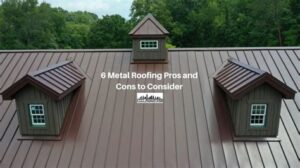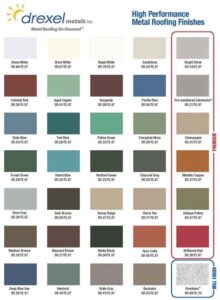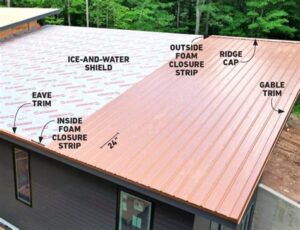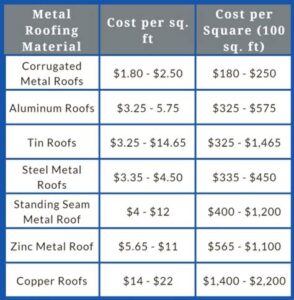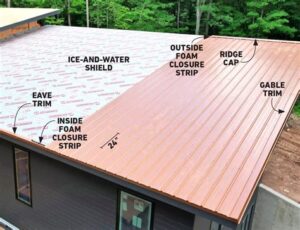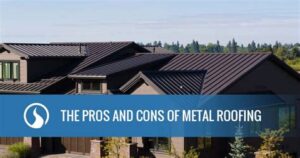Are you considering a home upgrade that combines durability, style, and energy efficiency? Look no further than metal roofs! With a variety of types and benefits, metal roofing offers a transformative solution for homeowners looking to enhance their properties. In this article, we’ll explore the numerous advantages of metal roofs, guide you through selecting the right type for your climate, and provide essential installation tips to ensure a successful upgrade. Additionally, we’ll discuss maintenance practices to keep your roof in prime condition and compare costs to traditional roofing options. Join us as we delve into the world of metal roofs and discover how they can elevate your home’s aesthetic appeal and functionality.
Understanding The Benefits Of Metal Roofs For Your Home
When considering home renovations, one often overlooked option is the roof. Choosing a metal roof can be a game changer for your home, offering numerous benefits that not only enhance your property’s aesthetic appeal but also contribute to its functionality and longevity. Here are some key advantages of transforming your living space with metal roofs:
- Durability: Metal roofs are known for their outstanding durability and resilience against harsh weather conditions. They can withstand high winds, heavy snow, and even hail.
- Longevity: Unlike traditional roofing materials that may require replacement every 15-20 years, metal roofs can last 40-70 years or even longer with proper maintenance.
- Energy Efficiency: Many metal roofs come with reflective coatings that help reduce energy costs by reflecting solar heat, keeping your home cooler during hot summers.
- Low Maintenance: Metal roofs require minimal upkeep compared to asphalt shingles and will not rot, crack, or warp.
- Eco-Friendly: Made from recycled materials and fully recyclable themselves, metal roofs are an environmentally sustainable building option.
- Fire Resistance: Most metal roofing materials have a high fire resistance rating, providing an added layer of safety for your home.
- Increased Home Value: The installation of a metal roof can enhance your home’s resale value, making it an attractive feature for potential buyers.
In essence, opting to transform your home’s roof with metal can lead to significant long-term benefits, making it a wise investment for homeowners looking to improve their properties.
How To Choose The Right Metal Roof Type For Your Climate
Choosing the right metal roof type for your climate is crucial for ensuring its longevity, energy efficiency, and overall performance. Different metal roofing materials respond differently to environmental conditions, so understanding your local climate can help you transform your home’s roofing system effectively. Here are some factors to consider:
| Climate Type | Recommended Metal Roof Type | Benefits |
|---|---|---|
| Temperate | Steel or Aluminum | Cost-effective, better durability, and a wide range of styles. |
| Hot and Dry | Aluminum | Resistant to corrosion, lightweight, and reflects heat effectively. |
| Cold and Snowy | Steel (Galvanized or Galvalume) | Handles heavy snow loads and prevents ice dam formation. |
| Coastal Areas | Aluminum or Galvalume | Resistant to salt corrosion, ideal for maritime climates. |
In addition to climate, consider the following aspects when selecting your metal roof:
- Color and Finish: Lighter colors reflect more sunlight, reducing heat absorption.
- Material Thickness: Thicker materials typically offer better durability against harsh weather.
- Installation Method: Certain methods, such as standing seam, may provide better insulation and moisture management.
By carefully evaluating these factors, you can ensure that your new metal roof not only meets aesthetic preferences but also stands up to the challenges posed by your specific climate — thereby allowing you to truly transform your home. Don’t hesitate to consult a local roofing expert who can provide tailored recommendations for your situation.
Transform Your Home With Metal Roof Installation Tips
When you’re ready to Transform Your home with a metal roof, installation is a critical step that can significantly affect the performance and longevity of your roof. Here are some essential tips to ensure a successful installation:
- Hire Professionals: While DIY projects can be rewarding, metal roof installation requires specialized skills and tools. Hiring professional roofers with experience in metal roofing systems ensures proper installation and adherence to local building codes.
- Choose Quality Materials: Selecting high-quality metal roofing materials is vital for longevity. Consider options like galvanized steel, aluminum, or copper, and ensure they come with a warranty for peace of mind.
- Prepare the Framework: Ensure your roof structure is sound before installation. This may involve reinforcing the existing framework to support the added weight of a metal roof. Proper insulation is also crucial to enhance energy efficiency.
- Plan for Ventilation: Adequate ventilation beneath the metal roof will prevent moisture buildup and reduce energy costs. Incorporate ridge vents or exhaust vents to enhance airflow.
- Follow Manufacturer Guidelines: Different metal roofing systems have unique installation requirements. Always refer to the manufacturer’s guidelines for the specific type of metal roofing you choose.
- Consider Weather Conditions: Plan your installation day when the weather is dry and calm. Rain or strong winds can complicate the installation process and pose safety hazards.
- Seal Those Joints: Properly sealing joints and seams during installation is crucial to prevent leaks. Use high-quality sealants and fasteners recommended by your metal roofing manufacturer.
- Inspect Post-Installation: After installation, conduct a thorough inspection to check for any loose fasteners, gaps, or areas that may require additional sealing. Address any issues promptly to ensure your metal roof’s longevity.
By following these tips, you can Transform Your home’s exterior while ensuring a durable, efficient, and aesthetically pleasing metal roof installation.
Maintaining Your Metal Roof: Essential Care And Practices
To ensure your metal roof remains in optimal condition and continues to effectively transform your home, regular maintenance is crucial. Here are some essential care practices you should adopt to prolong the lifespan of your metal roof:
- Regular Inspections: Schedule inspections at least twice a year, ideally in spring and fall. Look for signs of wear, rust, and damage, particularly after severe weather events.
- Clean Debris: Remove leaves, branches, and other debris from your roof surface and gutters to prevent water pooling and potential rust formation.
- Wash The Roof: Use a mild detergent and water solution to wash your metal roof. This helps eliminate dirt and prevent the buildup of corrosion-causing contaminants.
- Check Seams and Fasteners: Ensure that all seams and fasteners are secure and free from corrosion. Replace any worn-out screws or seals to maintain a watertight seal.
- Rust Treatment: If you notice any rust spots, treat them immediately with a rust-inhibiting primer and appropriate paint to prevent further damage.
- Inspect Flashing: Inspect and maintain the flashing around chimneys, vent pipes, and walls to ensure a tight seal and prevent leaks.
By following these essential maintenance practices, you can effectively transform your home’s exterior while ensuring the longevity and performance of your metal roof. Regular care not only protects your investment but also enhances the aesthetic appeal of your home.
Comparing Costs: Metal Roofs Vs Traditional Roofing Options
When considering a roofing upgrade, understanding the financial implications is essential. The transform your home’s aesthetic and functional aspects can significantly impact your investment. Below, we’ll compare the costs associated with metal roofs and traditional roofing options to help you make an informed decision.
| Roof Type | Initial Cost (per square foot) | Average Lifespan | Maintenance Costs (per year) |
|---|---|---|---|
| Metal Roofs | $7 – $12 | 40 – 70 years | $0 – $300 |
| Asphalt Shingles | $3 – $5 | 15 – 30 years | $200 – $400 |
| Wood Shingles | $6 – $9 | 20 – 25 years | $200 – $500 |
| Tile Roofs | $10 – $18 | 50 – 100 years | $200 – $400 |
As the table illustrates, while metal roofs have a higher initial cost compared to traditional options like asphalt and wood shingles, their longevity and low maintenance needs can make them a more cost-effective choice in the long run. For homeowners who wish to transform your home’s value and performance, investing in a metal roof may yield significant savings over time.
Additionally, consider factors such as local climate, energy efficiency, and resale value. Metal roofs often reflect sunlight, helping to reduce energy costs, an aspect that traditional roofs may not offer to the same extent. By understanding these financial factors, you can make the best decision for your roofing needs.
Frequently Asked Questions
What are the main benefits of installing a metal roof?
Metal roofs are known for their durability, energy efficiency, and minimal maintenance requirements. They can withstand harsh weather conditions, reflect heat, and last up to 50 years or more.
What are the different types of metal roofing materials available?
The most common types of metal roofing materials include steel, aluminum, copper, and zinc. Each material offers unique benefits and aesthetic options for homeowners.
How do metal roofs compare to traditional roofing materials?
Metal roofs generally outlast traditional roofing materials like asphalt shingles, provide better insulation, and require less frequent repairs, making them a cost-effective long-term investment.
Are metal roofs noisy during rain or hail?
While some homeowners worry about noise, installing insulation and underlayment materials significantly reduces sound. Most people find the noise level acceptable compared to traditional roofs.
Can metal roofs be installed over existing roofing?
Yes, metal roofs can often be installed over existing roofing without needing to tear off the old roof, provided the existing structure is in good condition and follows local building codes.
What maintenance is required for metal roofs?
Metal roofs require minimal maintenance, but it’s recommended to have them inspected periodically for loose panels, rust, or debris buildup, ensuring they remain in excellent condition.
What styles and colors are available for metal roofs?
Metal roofs come in a variety of styles, including standing seam, corrugated, and shingles, and are available in numerous colors and finishes, allowing for a customizable look that complements any home.
